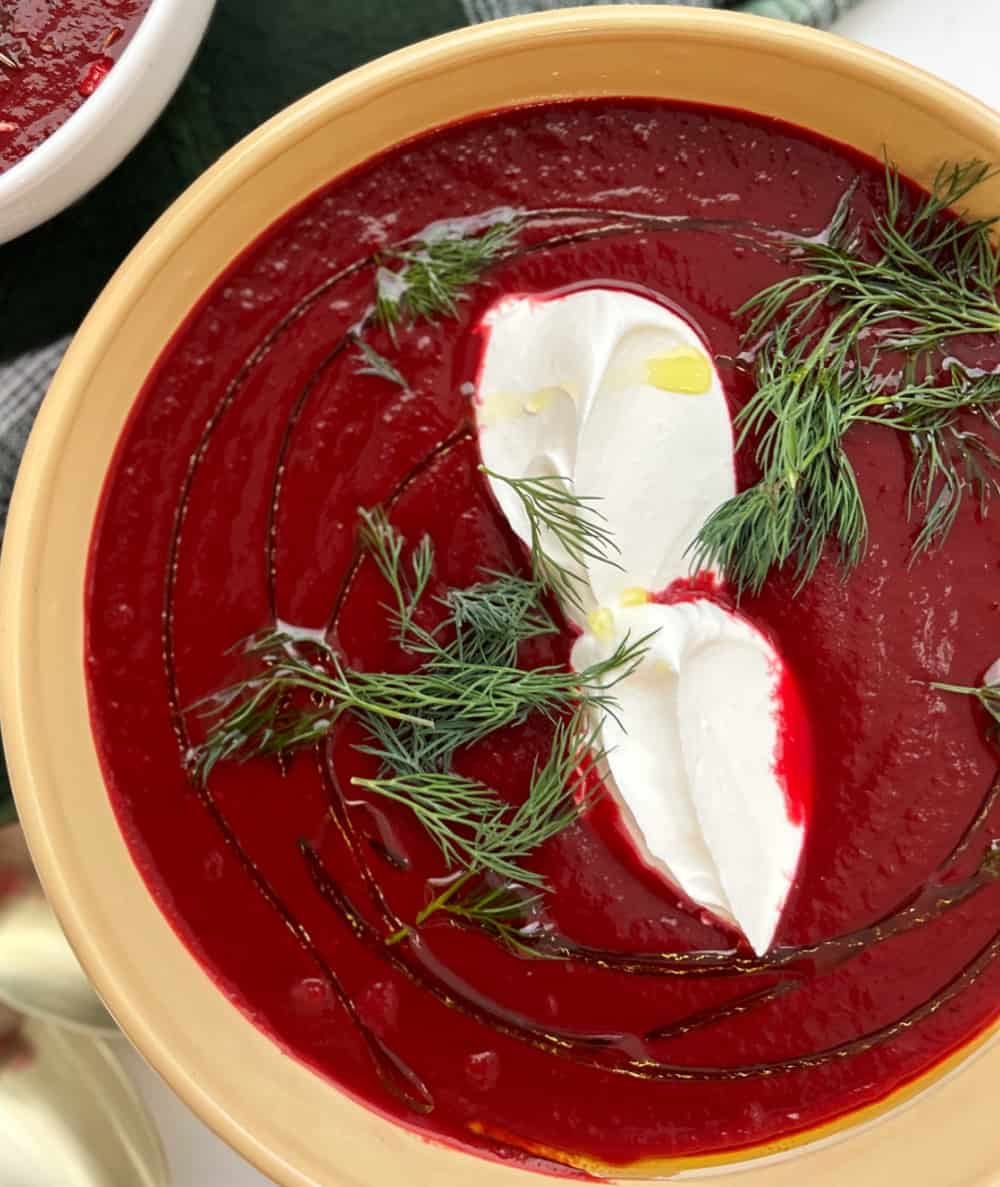
Creamy Ukrainian Borscht Recipe by Jaíne Mackievicz
This traditional Creamy Ukrainian Borscht recipe from Jaíne Mackievicz, winner of the Food Network’s Julia Child Challenge, pays homage to her grandmother Rosa, who served the soup often. Rosa’s not-so-secret ingredient for getting depth of flavor in this vegetarian borscht recipe was a handful of prunes – and that’s just how Jaíne makes the soup too.
from Jaíne:
The mother of my father, my babushka Rosa, was a tall, bossy, and very persistent Ukrainian lady. She made it to 92 and ate incredibly well until her last day. Born Filakosky in western Ukraine, she took the name Mackievicz from my grandfather after marrying him. She always made sure to keep her mother tongue sharp for both cursing her kids and blessing us grandkids.
Making the borscht for family:
Rosa would peel beetroots letting the juices permeate her wrinkled hands. Then she would dice them and spread them on a sheet pan, mingling them with other diced vegetables and some oil — her hands orchestrating it all. She’d put the tray in the oven to roast and sit with a mug of tea by the kitchen window. She would stare at the nothingness outside during those 50 roasting minutes.
When the vegetables were soft, she would hand blend them into a creamy soup, seasoning it really well with salt and red wine vinegar. She would serve us, in her white enamel plates, ladlefuls of her warm, crimson-colored soup with dollops of immaculate sour cream on top.
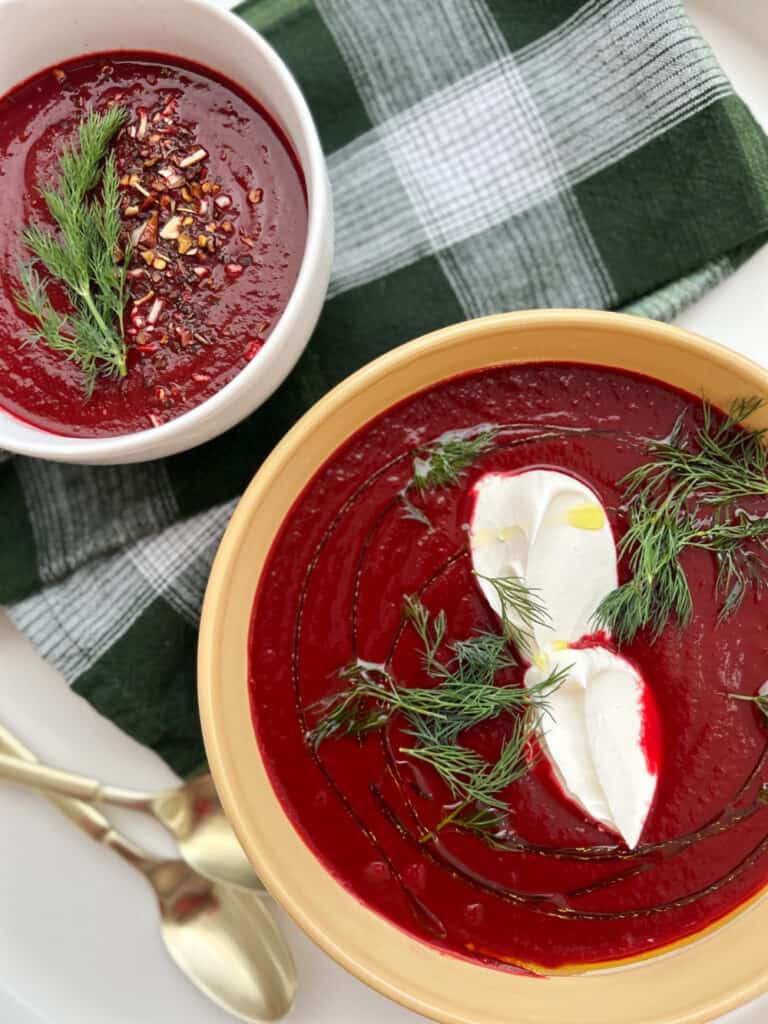
About this borscht recipe:
Sweet, sour, and creamy. Vegan without the sour cream, too, this is my favorite soup my Ukrainian grandmother used to make. You might find a traditional borscht recipe, as other cooks tend to add tomato or tomato paste and season it with a touch of pepper — there are so many approaches to this national soup. This version I make so often at home comes really close to what I tasted from my grandma’s spoon. She blended hers, and I blend mine, too, but you can skip this step completely if you prefer it chunky — it tastes as good. The real secret is to get the vegetables really tender and caramelize. The prunes she added to roast with the vegetables are a bit of a secret, too.
Read the full story of this traditional borscht recipe here.
More traditional Ukrainian dishes:
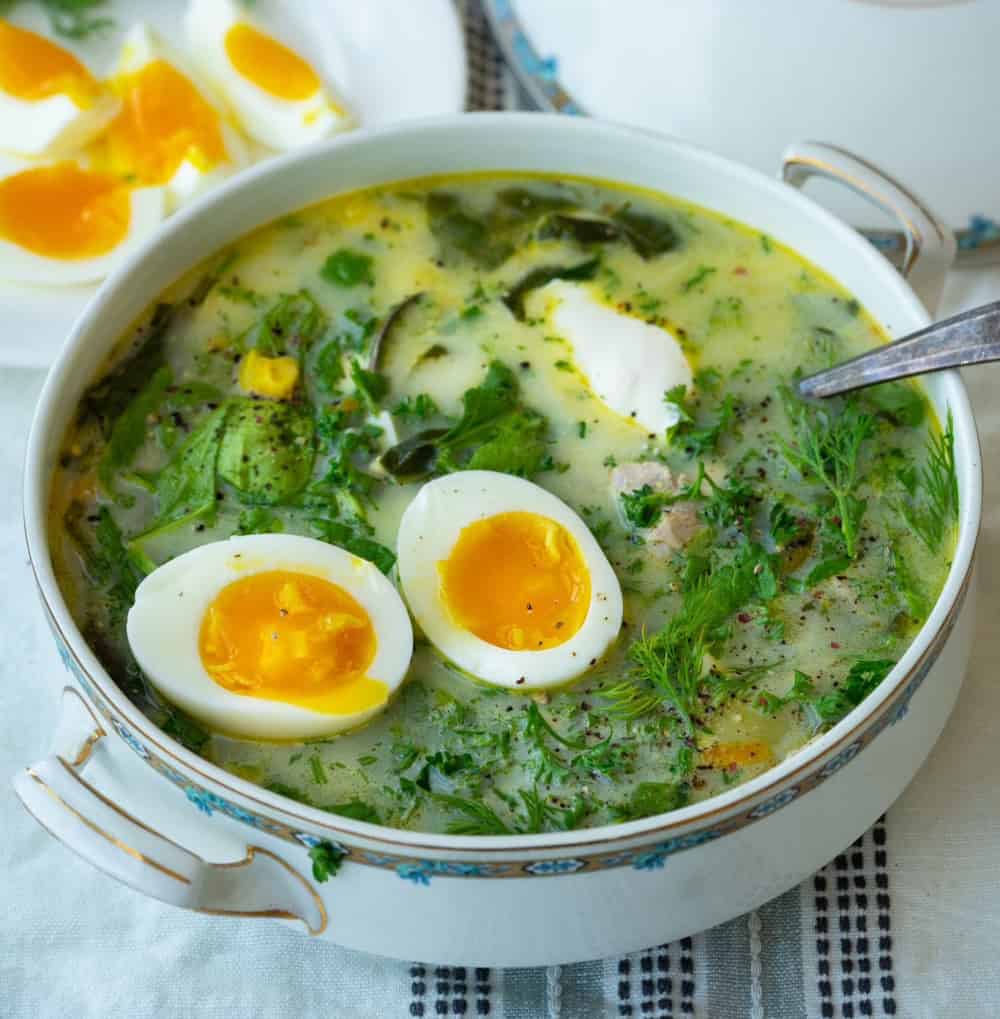
Green Borshch/Green Borscht Recipe
Jaíne shares Anna Voloshyna’s recipe for Green Borshch – which is sometimes also spelled Borscht, on her website and newsletter. Green Borshch is believed to have originated in the southern regions of Ukraine, where the climate is warm and conducive to growing a variety of green vegetables and herbs, including tangy sorrel that gives the soup its signature sour flavor.
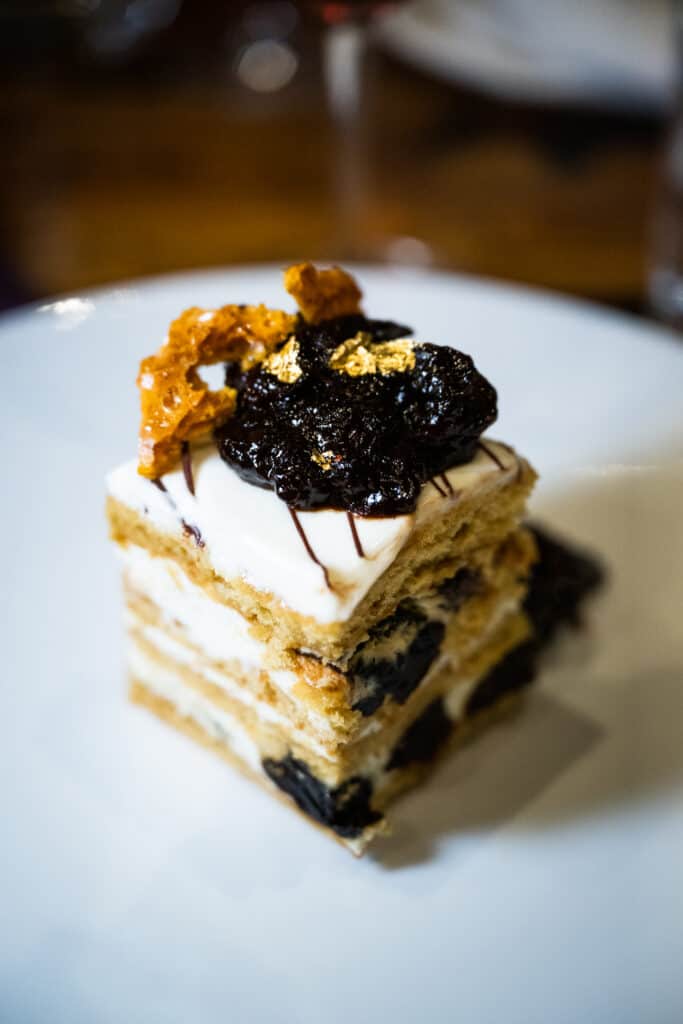
Traditional Ukrainian Honey Cake
This light and airy traditional Ukrainian Honey Cake from Pastry Chef Misty Olsen Green of Hawks Public House is loaded with delicious California Prunes and adds the perfect finishing touch to your meal. The recipe is direct from Misty’s grandmother, who made this prune and honey cake regularly.
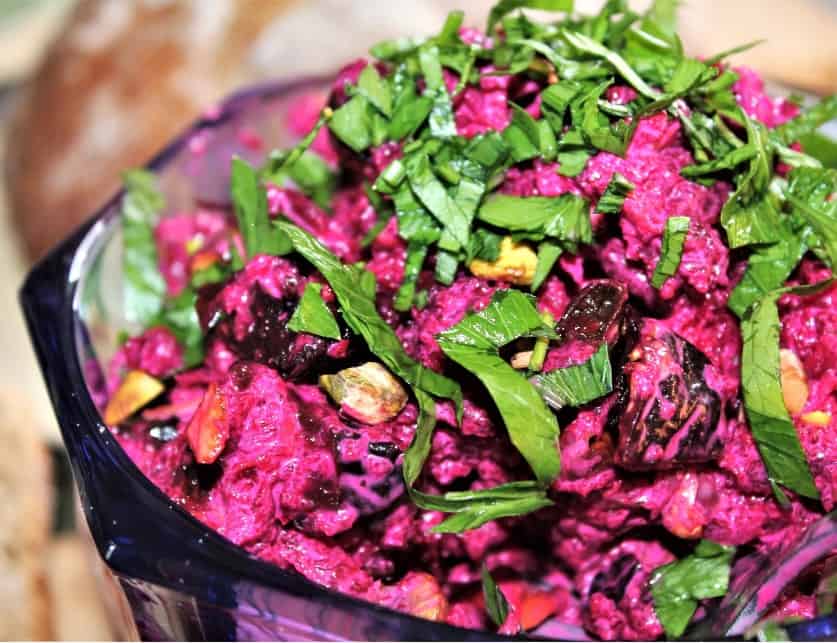
Beet Salad with Prunes and Pistachios
This Ukrainian style Beet Salad with Prunes and Pistachios from Inna of Innichka Chef comes together with just a few ingredients , and is full of healthy goodness and flavor.
Wait, is it Borsch, Borshch or Borscht? Which is correct?
In truth, all of these spellings: Borsch, Borshch or Borscht – and you can throw Borsht in too – are considered correct. Borscht derives from an ancient soup originally cooked from pickled stems and leaves of hogweed. Eventually, it evolved into a diverse array of tart soups, with the beet-based Ukrainian version, red borscht, becoming the most popular. In 2022, the United Nations Educational, Scientific, and Cultural Organization (UNESCO) placed borscht on the List of Intangible Cultural Heritage in Need of Urgent Safeguarding because of the risk the Russian invasion posed to the soup’s status as part of Ukraine’s cultural heritage.
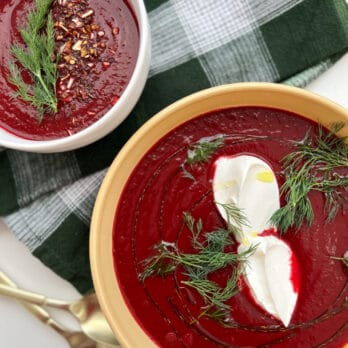
Creamy Ukrainian Borscht
Jaíne MackieviczIngredients
- 2 medium beets or 3 small ones
- 2 medium carrots or 3 small ones
- 1 large red onion
- 1 head garlic I know it sounds like a lot, but trust me
- 4-6 California prunes Rosa’s secret for depth of sweetness
- 4 bay leaves
- 1 tbsp olive oil
- 1 1/2 to 2 tsp table salt or 2 1/2 tsp kosher salt to be used in two stages
- 1/2 head green cabbage
- 8 cups water or vegetable broth
- 3 tbsp red wine vinegar
- Sour cream & dill to serve; sourdough to dip.
Instructions
- Preheat the oven to 400°F (200°C).
- Cut the beets, carrots, and onion into 1 1/2-inch chunks, halve the head of garlic, and place them on a baking sheet with the prunes and bay leaves (line it with parchment to avoid stains). Drizzle with olive oil and season with 1 tsp of salt.
- *If my beets and carrots are organic, I don’t even bother peeling them.
- Roast the vegetables in the preheated oven for 45-55 minutes, or until, if tested with a fork, they are tender and caramelized (especially the head of garlic).
- About 15 minutes before your timer for the roasting veggies goes off, in a large pot, bring the water or vegetable broth to a boil.
- Quarter the half head of green cabbage, discarding the hard part of the center. Add the cabbage to the broth, stir well, and bring it to a simmer. Let it simmer for about 10 minutes, or until the cabbage looks translucent and thoroughly cooked.
- When your veggies are done, take the tray out of the oven, pick out the garlic, squeeze it into the pot of simmering cabbage, and discard the peel. Transfer everything else from the baking sheet to the pot, including the bay leaves.
- Cover the pot and let the borscht simmer for 10 minutes, or until the flavors have melded together. Skim the top to remove any foam.
- Remove the bay leaves from the pot and use an immersion blender or a regular blender to puree the soup until smooth. If using a regular blender, be sure to allow the soup to cool slightly before blending to prevent burns.
- Stir in the red wine vinegar and season the soup with the additional 1/2 tsp of salt, if needed. Be careful with the salt to not compromise the natural sweetness of the vegetables combined with the prunes. Taste and adjust as you go — I never had to use more than 2 tsp of salt.
Notes
Nutrition
More Red Borscht Recipes to try:
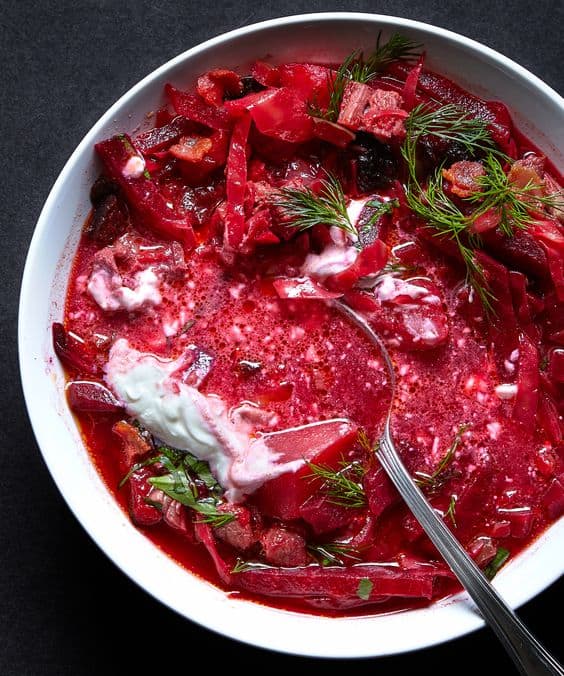

Jaíne Mackievicz moved to the United States from the Brazilian Amazon in 2017 with one goal in mind. She wanted to learn to cook like her childhood hero, Julia Child.
She had originally hoped to attend the Gastronomy program at Boston University. When that didn’t work out, something different (or as she’ll tell you, something magical) fell into place. Jaíne had written a wildly successful article for the Julia Child edition of Cherry Bombe magazine. Her work made an impression on folks in the culinary world. When Food Network was casting the 2022 Julia Child Challenge, Jaíne was invited to audition – and won. She’s in the process of writing her first cookbook and maintains a weekly newsletter, Dinner at Jaíne’s.
Want more of Jaíne’s recipes? Try her delicious Coconut Pots de Crème with Rum-Stewed Prunes next, and her Arroz de Festa too.